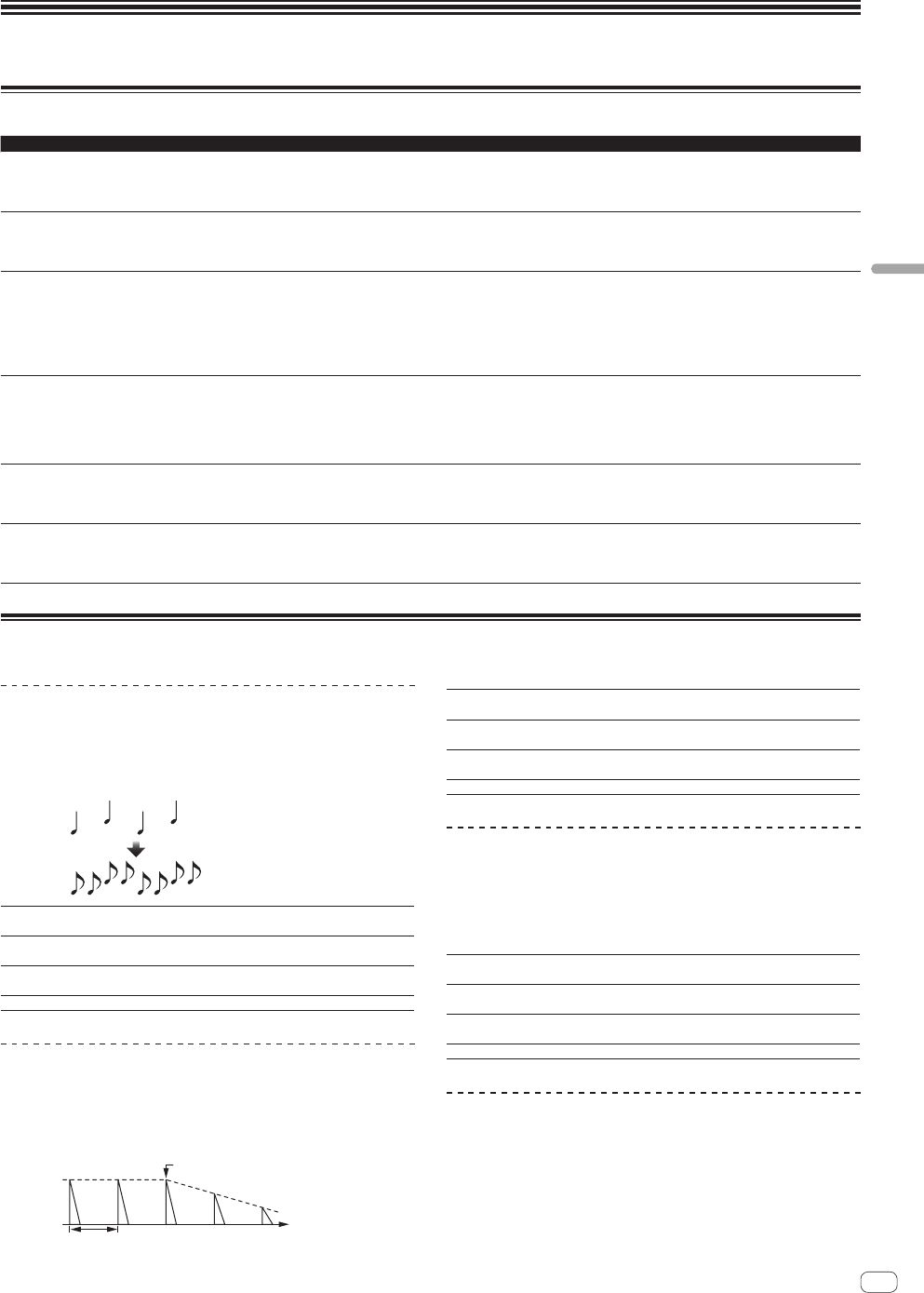
En
15
Types of effects
Types of effects
Types of SOUND COLOR FX effects
Effect Name Descriptions [COLOR] control [PARAMETER] control
SPACE
Applies a reverberation effect to the original
sound.
Turn counterclockwise: Applies the reverbera-
tion effect to the mid- and low ranges.
Turn clockwise: Applies the reverberation
effect to the mid- and high ranges.
Turning the control to the right increases
feedback.
DUB ECHO
Applies an echo effect, with the sound delayed
slightly after the original sound output several
times and gradually attenuated.
Turn counterclockwise: Applies the echo
effect to the mid-range only.
Turn clockwise: Applies the echo effect to the
high range only.
Turning the control to the right increases
feedback.
SWEEP
Turning the control to the left produces a gate
effect, and turning it to the right produces a
band pass filter effect.
Turn counterclockwise: A gate effect makes
the sound tighter, with a reduced sense of
volume.
Turn to right: The band pass filter bandwidth
decreases steadily.
Turning the [COLOR] control to the left adjusts
the gate effect.
Turn to the right to tighten the sound.
Turning the [COLOR] to the right adjusts the
center frequency.
Turn to the right to increase the center
frequency.
NOISE
White noise generated inside this unit is
mixed in to the sound of the channel via the
filter and output.
Turn counterclockwise: The cut-off frequency
of the filter through which the white noise
passes gradually descends.
Turn clockwise: The cut-off frequency of the
filter through which the white noise passes
gradually rises.
Turn to the right to increase white noise
volume.
!
The sound quality can be adjusted by
turning the [EQ/ISO (HI, MID, LOW)]
control.
CRUSH
Changes the original sound to a crushed-like
sound for output.
Turn counterclockwise: Increases the
sound’s distortion.
Turn clockwise: The sound is crushed before
passing through the high pass filter.
The further the control is turned clockwise, the
more the effect is stressed.
FILTER
Outputs sound that has passed through a
filter.
Turn counterclockwise: Gradually descends
the low-pass filter’s cutoff frequency.
Turn clockwise: Gradually rises the high-pass
filter’s cutoff frequency.
Turn to the right to increase resonance.
Types of BEAT FX
DELAY
1
A delay sound is output once according to the beat fraction set with the
[BEAT c, d] buttons.
! Lowering the channel faders and cutting the input volume leaves a
delay sound.
Original
(4 beats)
1/2 delay
(8 beats)
BEAT c, d buttons
(parameter 1)
Sets the delay time between 1/16 and 16 beats with
respect to 1 beat of BPM time.
TIME control (parameter 2)
Use this to set the delay time.
1 to 4000 (ms)
LEVEL/DEPTH control
(parameter 3)
Use this to set the balance between the original
sound and the delay sound.
X-PAD (parameter 4) Use this to set the delay time.
ECHO
1
A delay sound is output several times and gradually attenuated accord-
ing to the beat fraction set with the [BEAT c, d] buttons.
!
Lowering the channel faders and cutting the input volume leaves an
echo sound, producing a fade out.
Time
Fade-out
BEAT c, d buttons
(parameter 1)
Sets the delay time between 1/16 and 16 beats with
respect to 1 beat of BPM time.
TIME control (parameter 2)
Use this to set the delay time.
1 to 4000 (ms)
LEVEL/DEPTH control
(parameter 3)
Use this to set the balance between the original
sound and the echo sound.
X-PAD (parameter 4) Use this to set the delay time.
PING PONG
1
Outputs multiple times while the delay sound is attenuated with different
delay timing to the left and right, in sync with the scaled beat set with the
[BEAT c, d] buttons, producing a stereo effect.
! Lowering the channel faders and cutting the input volume leaves an
echo sound, producing a fade out.
BEAT c, d buttons
(parameter 1)
Sets the delay time between 1/16 and 16 beats with
respect to 1 beat of BPM time.
TIME control (parameter 2)
Use this to set the delay time.
1 to 4000 (ms)
LEVEL/DEPTH control
(parameter 3)
Use this to set the balance between the original
sound and the echo sound.
X-PAD (parameter 4) Use this to set the delay time.
SPIRAL
1
This function adds a reverberation effect to the input sound.
When the delay time is changed, the pitch changes simultaneously.
! Lowering the channel faders and cutting the input volume leaves an
effect sound.
